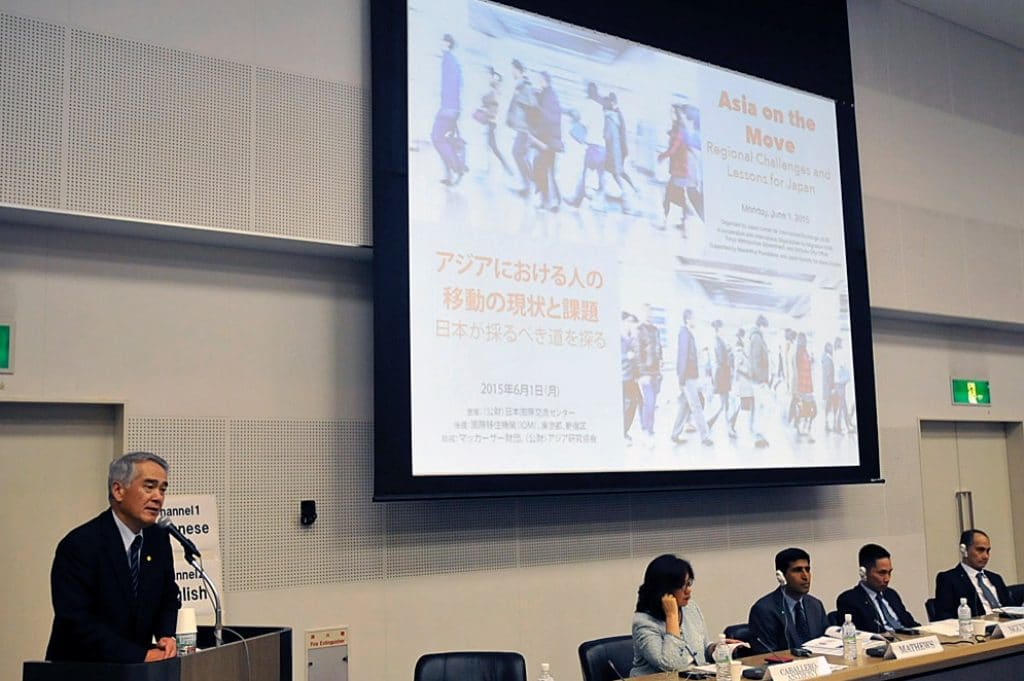The UN estimates that there were 71 million international migrants in Asia in 2013. As globalization and regional ties in East Asia have progressed, critical questions have arisen: How can the movements of people be managed in such a way that ensures individual, national, and regional security and prosperity? How can cross-sectoral collaboration be enhanced? And what role does civil society have to play in that process?
On June 1, 2015, JCIE held a symposium in Tokyo to share the findings of a multinational case study project on The Movement of People in East Asia and the Role of Civil Society. The study examined eight countries—China, Indonesia, Japan, Korea, Myanmar, the Philippines, Singapore, and Vietnam—to explore what kind of regional cooperation and networks would best serve to build a human security–focused immigration system in East Asia, and also considered directions that Japan should take in response to depopulation and aging.
Summaries of Papers: English | Japanese
| Japanese
Session 1: Asia on the Move—The Search for Human Security-Focused Systems
In Session 1, researchers from four countries—Singapore, Korea, Vietnam, and the Philippines—described new trends and challenges evident in the movement of people in their respective countries. A lively question and answer session, moderated by Dr. Mely Caballero-Anthony (S. Rajaratnam School of International Studies), followed comments by William Barriga (IOM Tokyo Country Mission Chief) and Professor Yasushi Iguchi (Kwansei Gakuin University) on the movement of people in Asia and regional issues.
Presentations
- Immigration and the Role of Civil Society in Singapore

Mathew Mathews, Senior Research Fellow, Institute of Policy Studies, Lee Kuan Yew School of Public Policy, National University of Singapore - Challenges and Responses to Immigration in Korea—National, Civil Society Organizations, and Migrant Workers
 [Japanese only]
[Japanese only]
Hyejin Lee, Program Associate, JCIE; Visiting Researcher, Institute of Comparative Economic Studies, Hosei University - Facilitating Labor Emigration for Security and Prosperity: the Case of Vietnam

Nguyen Thanh Liem, Deputy Director, Institute for Population, Health and Development, Vietnam; Researcher, Curtin University, Australia - Walk the Talk: Overseas Employment from the Phillipines, CSOs, and Migrant Workers

Jorge V. Tigno, Associate Professor and Chair, Department of Political Science, University of the Philippines
Session 2: Japan in Asia—Exploring Japan’s Strategy in the Face of Depopulation
In Session 2, former UN Under-Secretary-General Yasushi Akashi offered a keynote speech, which was followed by a presentation from Toshihiro Menju (Managing Director and Chief Program Officer) about Japan’s challenges in accepting immigrants.
Lastly, a panel of 33 officials from national and regional governments, businesspeople, journalists, representatives from the civil sector, and academics, engaged in a roundtable discussion about how best to accept and react to the present and future movements of people in East Asia. The roundtable discussion was moderated by economic journalist, Tomoyuki Isoyama. After representatives from regional governments shared their concerns about Japan’s depopulation problem, there was a lively debate about the acceptance of foreigners at the government level, new trends related to immigration, and future challenges. Organizations active in supporting immigrants then described the various challenges and problems facing immigrants. Pointing out the lack of national debate about the acceptance of immigrants, various recommendations were proposed, including one that called for incorporating various sectors in on the immigration debate. Many noted that this JCIE symposium was the first time that such a cross-sectoral dialogue on immigration had been held in Japan.
Presentations
- Keynote Speech
Yasushi Akashi, Chairman, International House of Japan; Former Under-Secretary-General of the United Nations - Japan’s Challenges in Accepting Immigrants
 [Japanese only]
[Japanese only]
Toshihiro Menju, Managing Director and Chief Program Officer, JCIE - Roundtable Discussion [Discussant List
 ]
]
Concluding Remarks
Dr. Caballero-Anthony emphasized the need to consider the movement of people in East Asia on various levels—government, business, NGO/NPO, and within the immigrant community—and that the human security viewpoint is essential. Also, because the movement of people is transnational, Japan must consider a regional framework that allows for the orderly and safe movement of people. Furthermore, a wider debate that includes other countries as well is needed.

